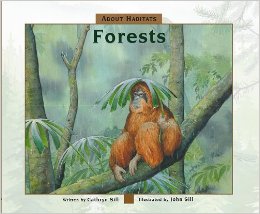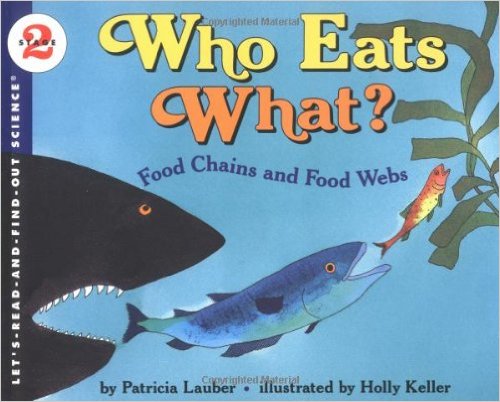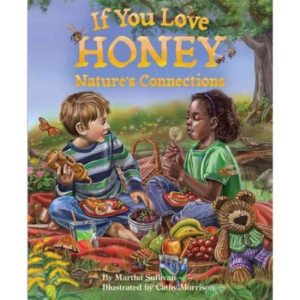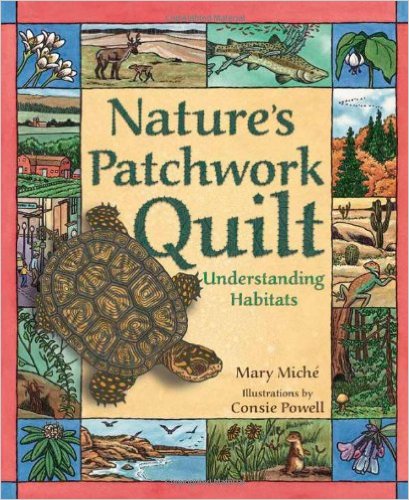We recommend the following fiction and non-fiction books for enhancing student learning on the topic of Energy in Ecosystems. Please note that this list is not exhaustive and that you may find other excellent books in your school or community library or at a local bookstore. Each of the unit activities also contains specific suggestions for using the books with your students. Look for these suggestions in the Enrich section of each activity.
In addition to the books, we offer a variety of online resources and apps you may use to support or extend your teaching of the unit activities.
Note: The books and resources listed below for a given activity are also listed in the Tools section of that activity.
For the Unit as a Whole
1: The Forest of S.T. Shrew
2: A Home for Many
3: Web of Life
4: Power Plants
5: Every Tree for Itself
6: Invasive Species
Activity 1: The Forest of S.T. Shrew
Books
Other Resources
Color the World!
Coloringnature.org offers more than 500 realistically illustrated coloring pages that can be downloaded and printed for use in preK-8 classrooms. Choose from categories such as amphibians, reptiles, mammals, birds, insects, animal homes, biomes and habitats, and trees. Consider pairing the pages with PLT activities as diagrams, models, or assessment tools.
NACD’s Soil Education Resources
The National Association of Conservation Districts (NACD) has created multiple online resources to help teach about the complexity of soil and what it means to all of us. Check out the Dig Deeper Poster for a quick reference or dig in deeper with educational tools to accompany NACD’s Annual Poster Contest.
Nature Pictures
Use PLT’s collection of S.T. Shrew Pictures to enhance either the skit or the narrative version of S.T. Shrew’s story.
Paper Plate Habitat
Florida PLT has created a Paper Plate Habitat template to be used in conjunction with the exploration of microhabitats. This document contains a list of materials, instructions, and images necessary for students to create their own habitats and to begin exploring the life and interrelationships found within.
Soil Explorers
The Soil Society of America hosts Soil 4 Kids. Students can learn about the importance of soil, soil-environment interactions, soil facts, and more. Activities, hands-on experiments, games, and career profiles of scientists in soil and environmental sciences are included for a comprehensive understanding of soil.
S.T. Shrew Reading and Writing Exercises
Developed by Florida PLT, Teacher’s Guide to Third and Fourth Grade Reading and Writing Exercises for In the Forest of S.T. Shrew includes activities for enhancing reading and writing based on S.T. Shrew’s story.
Unlock the Secrets in the Soil
Check out the Newspaper/Magazine Infographics from the U.S. Department of Agriculture’s Natural Resource Conservation Service! These royalty-free infographics colorfully illustrate what soil is made of and what it does.
Activity 2: A Home for Many
Books
Other Resources
AllTrails
A free app for Apple and Android devices, AllTrails helps users access trail maps to national parks or hiking paths near their homes. The app can also help them map new trails of their own.
Easychart
A free app for Apple or Android device, Easychart is a good tool for easily creating bar, line, and circle graphs. The app also works without an Internet connection.
iNaturalist
iNaturalist offers a great place to record and map observations of plants and animals. Each place page displays all the species that have been recorded for a given place, including information about their abundance, conservation status, and who was first to observe that species in that place on iNaturalist.org. You can also create a group page, for your school, for example.
LeafSnap
Leafsnap is a free app for iPhone and iPad (Android version in development) that uses visual recognition software to help identify tree species from individual leaf photographs you take in the field. Leafsnap is currently geared just for Northeastern United States species, but expansion to include all U.S. regions is underway.
Ordinary Extraordinary Junco
Video shorts from The Junco Project introduce one of North America’s most common groups of songbirds. Juncos can be readily observed in backyards, city parks, and forests alike, and also are interesting in terms of their animal behavior, ecology, and evolutionary biology.
Paper Plate Habitat
Florida PLT has created a Paper Plate Habitat template to be used in conjunction with the exploration of microhabitats. This document contains a list of materials, instructions, and images necessary for students to create their own habitats and to begin exploring the life and interrelationships found within.
Project Noah
Use the Project Noah online photo album for sharing wildlife pictures and documenting wildlife observations.
Schoolyard Habitat Project Guide
The Schoolyard Habitat Project Guide provides the basic steps needed to restore or create wildlife habitat on school grounds, incorporating critical thinking and decision-making skills while challenging students in reading, writing, science, mathematics, and language arts.
WildLab Bird
The Wildlab Bird is a free app for Apple devices (try iBird Lite for Android) to learn the basics of bird identification. This application uses audio, photographs, maps, and the process of elimination to help identify over 200 bird species. Sightings can also be entered into a national birdwatching database for comparison.
Activity 3: Web of Life
Books
Other Resources
For Student Research
Animals
A – Z Animals is an on-line, kid-friendly animal encyclopedia provides photos and brief information for many different species around the world.
Nat Geo Animal Facts
National Geographic Animal Facts includes great photos and fast facts about different animals. (Although designed for teens and older, the information is fairly easy to glean, even for younger students.)
Plants
The National Gardening Association Plants Database provides brief information on thousands of plants, which may be searched by common name.
USDA Plants Database
U.S. Department of Agriculture Plants Database contains information and photos for many different plants. (Younger students may need help navigating the site and deciphering some of the information. Be sure to select “common name,” unless you are searching by the Latin name.)
For Enrichment
Color the World!
Coloringnature.org offers more than 500 realistically illustrated coloring pages that can be downloaded and printed for use in preK-8 classrooms. Choose from categories such as amphibians, reptiles, mammals, birds, insects, animal homes, biomes and habitats, and trees. Consider pairing the pages with PLT activities as diagrams, models, or assessment tools.
ARKive’s “Survival” App
Full of real-life photographs, this fun Survival App tests speed, agility, endurance and intelligence, essential skills needed to become a Top Survivor as one of the world’s most endangered animals.
Endangered Species Interactive Map
The U.S. Fish and Wildlife Service’s Endangered Species Map provides information about endangered species success stories in every state, including audio interviews and podcasts with biologists about on-the-ground endangered species conservation.
American Bird Conservancy Video: Go Birding, Save Species!
Go Birding, Save Species is a one-minute video from the American Bird Conservatory featuring a dozen different birds in action. Visit www.conservationbirding.org for a full species list.
Encounters: Wild Explorer
The public radio program Encounters: Radio Experiences in the North explores the natural history of Alaska and the Far North. The website also includes videos, sound clips, and other resources to introduce the animals and habitats of the region.
Conservation Connect LIVE! Broadcasts
Connect your students with conservation professionals using the U.S. Fish and Wildlife Service’s broadcast series, Conservation Connect LIVE!, choosing among a variety of topics.
Webspiration
Use the Webspiration online tool to create food webs, concept maps, and other diagrams.
Activity 4: Power Plants
Books
 |
Bang, Molly and Penny Chisholm. Living Sunlight: How Plants Bring the Earth to Life. Blue Sky Press. 2009. Through beautiful illustrations and poetic text, this book helps children understand both the process and importance of photosynthesis. Grades 2–6. ISBN: 978-0545044226. |
Other Resources
3-D Leaf Model
Use a 3-D Leaf Model from Kessler Science to help students better understand photosynthesis.
Digital Game: The Ruby Realm
The Ruby Realm is a multi-level adventure game about photosynthesis. Players must navigate a cavern in search of missing friends with the help of Biobot Bob, a robot powered by artificial photosynthesis.
Easy Chart
A free app that can be downloaded onto Apple or Android devices. This is a good tool for teachers and classrooms. Easily create bar, line and pie charts that you can customize, save and e-mail or upload. The charts you create can be saved using multiple color schemes and in multiple sizes. The app also works without an internet connection.
Photosynthesis Demonstration
Watch PLT’s Photosynthesis Demonstration video, which depicts an alternative to the “Engage” demonstration in the activity. In the video, teacher Beverly Goodger offers some additional variations on this experiment.
Exploring the Secret Life of Trees
The Exploring the Secret Life of Trees animated presentation for students in grades 3-5 explains in detail how an acorn becomes a tree. The audio is available in English and Spanish.
Activity 5: Every Tree for Itself
Books
Other Resources
Easychart
A free app for Apple or Android device, Easychart is a good tool for easily creating bar, line, and pie charts. The app also works without an Internet connection.
Every Tree for Itself Example
Watch a video of PLT’s Every Tree for Itself activity being presented by a teacher in her classroom. You can see how this teacher adapts this activity for her students and maybe get some ideas for your classroom.
Tree Rings Simulation
An interactive “Tree Rings Simulation” from the University Corporation for Atmospheric Research’s Center for Science Education allows your students to model a tree’s growth rings by selecting the level of moisture available.
Activity 6: Invasive Species
Books
Other Resources
Beetle Busters
The U.S. Department of Agriculture’s Asian Longhorned Beetle website presents information about this pest along with curriculum materials for grades 4–12.
Global Invasive Species Database
The Invasive Species Specialist Group (ISSG) has compiled a list of “100 of the World’s Worst Invasive Alien Species.” View photos and learn more about these species’ habitats, impacts, uses, and geographical ranges.
Invasive Species 3-D Paper Models
The Regional Municipality of York has downloadable Emerald Ash Borer and Asian Longhorned Beetle 3-D paper models for teachers, adults, and children. Be sure to find and share the part of the template that depicts the actual adult size of these invasive species.
Nab the Aquatic Invader
Nab the Aquatic Invader teaches students in grades 4-10 about aquatic invaders and the problems they create. Produced by NOAA and the Sea Grant Program, the website features games and activities for students, as well as background information on each species.
National Invasive Species Information Center
Find resources and information about invasive species in your state using the National Invasive Species Information Center database. Select “Browse by Geography” to begin your search.
Plant Heroes
The American Public Gardens Association assembled a team of Plant Heroes to detect and combat bugs and diseases that harm plants and ecosystem health, particularly the Emerald Ash Borer, Asian Longhorned Beetle, Redbay Ambrosia Beetle, and Ramorum Blight. Using games, comics, printables, and field guides, the website allows students to learn more about these invasive species.
Use of Giant African Land Snails in Classrooms
Giant African Land Snails are illegal in the continental United States because they are highly invasive and can cause extensive damage to agricultural and natural resources. See this important message from the U.S. Department of Agriculture to educators about the risk involved in using Giant African Land Snails in science lessons.
What Is an Invasive Species?
Use the U.S. Fish and Wildlife Service’s What Is an Invasive Species? website to learn what invasive species are, what people can do about them, and which species might be found in your area.


































